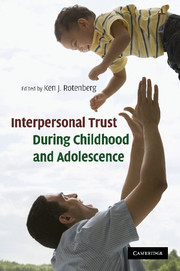Book contents
- Frontmatter
- Contents
- List of figures
- List of tables
- List of contributors
- Section I Conceptual foundations and issues
- 1 Introduction
- 2 The conceptualization of interpersonal trust: A basis, domain, and target framework
- 3 Neurobiology of interpersonal trust
- 4 Children's sense of trust in significant others: Genetic versus environmental contributions and buffer to life stressors
- Section II Childhood
- Section III Adolescence and early adulthood
- Index
- References
2 - The conceptualization of interpersonal trust: A basis, domain, and target framework
Published online by Cambridge University Press: 04 August 2010
- Frontmatter
- Contents
- List of figures
- List of tables
- List of contributors
- Section I Conceptual foundations and issues
- 1 Introduction
- 2 The conceptualization of interpersonal trust: A basis, domain, and target framework
- 3 Neurobiology of interpersonal trust
- 4 Children's sense of trust in significant others: Genetic versus environmental contributions and buffer to life stressors
- Section II Childhood
- Section III Adolescence and early adulthood
- Index
- References
Summary
The notion that trust is crucial to psychosocial functioning has been advanced since the beginning of contemporary psychology (see Simpson, 2007). Erikson (1963) proposed that trust is formed during infancy and affects psychosocial functioning during the life-course. Similarly, attachment theorists propose that infants' trust is a product of their interactions with caregivers that, via its role in a cognitive model (the internal working model [IWM]), affects subsequent social functioning (Armsden and Greenberg, 1987; Bridges, 2003; Waters, Vaughn, Posada, and Kondo-Ikemura, 1995). Researchers have emphasized the role that trust plays in relationships with parents and peers across childhood and adolescence (see Bernath and Feshbach, 1995; Harris, 2007). Also, trust has been regarded as a critical facet of romantic relationships during adulthood (e.g., Holmes and Rempel, 1989; Mikulincer, 1998; Miller and Rempel, 2004).
A major problem confronting a researcher is how to conceptualize and assess interpersonal trust. This type of problem is frequently encountered in the discipline of psychology, where researchers examine constructs that correspond to commonly understood terms or concepts: ones that tap into individuals' naïve notions of psychosocial functioning. As a consequence, the conceptualization of trust is a very thorny problem, because a researcher's conceptualization may not match those commonly held by a social community, thus appearing to be disconnected from social reality. Researchers might attempt to avoid such problems by assessing individuals' perceptions or reports of trust per se. Unfortunately, this method is very limited because the meaning of the measure is unclear.
- Type
- Chapter
- Information
- Interpersonal Trust during Childhood and Adolescence , pp. 8 - 27Publisher: Cambridge University PressPrint publication year: 2010
References
- 42
- Cited by



